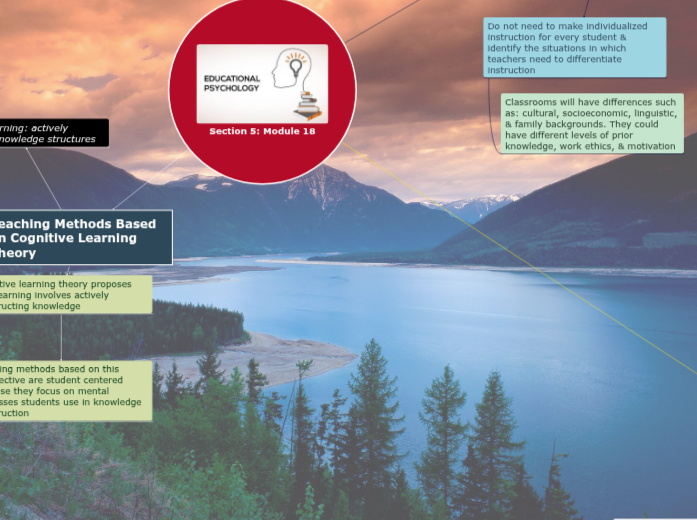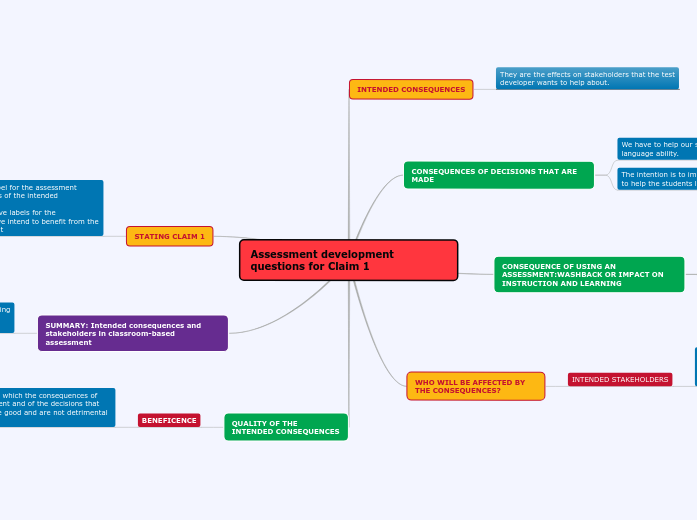por Jessika Vroman 5 anos atrás
387
Module 18

por Jessika Vroman 5 anos atrás
387

Mais informações


por Ma. Camila Barragán Pantoja


por Ana Duran


por Ethan Kwan


por Joe Russo
proposes that an individual's behavior is the result of two environmental stimuli: antecedents & consequences
consequences: are stimuli that either strengthen the likelihood that the behavior will occur again or reduce the future occurrences of the behavior
Antecedents: are stimuli or situations that signal that a behavior is expected
roots in operant conditioning
Can be used for all grade levels as well as basic skills curriculum to more complex material
Students who need extra time or teacher feedback to achieve mastery are allowed this opportunity. Those that master after intial teaching may be given enrichment or extension activities
Compared to traditional instruction, well-implemented mastery learning leads to higher school achievement & increased confidence & academic self-concept
May also increase achievement gap rather than decrease it
Summative assessment to test what student has learned
Providing students with feedback about their progress
Presenting material to students, who typically work individually & independently
Conducting a formative assessment-a brief diagnostic test to assess students' current level of performance before instruction & to determine areas needing improvement
Dividing major learning objectives into smaller units from simple to complex, with each unit having its own learning objectives
Developing major learning objectives representing a course or unit
Teachers set a prespecified mastery level such as 80% on a unit test.
Beneficial for:
for improving language skills of children with autism
for delivering interventions to improve mathematical difficulties
as an initial instructional strategy for lower achieving students
lower level objectives in Bloom's taxonomy & for improving students' basic skills in reading & mathmatics
Effective regardless of subject, students SES background, ethnic identity, or disability status
4. Distributed practice
process of spreading out practice over a period of time
short, frequent practice periods are more effective than fewer, longer practice opportunities, especially kids in early elem grades
3. Independent practice
when students are able to practice knowledge or skills with about 85% or 90% accuracy
Homework is an example of independent practice
2. Guided practice
students practice on their own while teacher provides reinforcement & corrective feedback
1. Controlled practice
the teacher leads students through examples, provide immediate corrective feedback
Requires careful monitoring to prevent students from learning incorrect procedures or concepts
Effective teachers: provide feedback, tell students what is correct, prompt them for clarification or improved answers, & reteach when necessary
Begin with: review previous day's lecture & check student work
Next introduce new content by activating prior knowledge through discussion of the learning objective e or an overview of the lesson
These steps of identifying the learning objective or lesson overview provides students with a purpose for learning the material & an overall procedure for how material is to be learned
This helps improve student achievement
Expository teaching
Also called meanigful verbal learning
goal is NOT to have students independently discover the to be learned content but to ensure new info will be integrated into learners memory in a meaningful way
teachers start by emphasizing the new content to what students already know & do real life examples & situations
Advance organizer
also enhances learning & promote transfer especailly when new material is unfamiliar or difficult
consists of concrete models or anaglogies presented either verbally or graphically, rather than abstract examples or principles
They are not just outlines they can be visual presentations such as a flow chart or an analogy
a tool that presents general info & provides a structure where that info can be integrated
Discovery learning
Guided discovery is a form of discovery learning
teacher provides enough guidance to ensure that students discover the rule or principal to be learned
the structure & guidance allow students to focus on cognitive resources on integrating & reorganizing knowledge & making inferences
to be successful: teachers must consider individual abilities and needs of students
can be effective for development of conceptual knowledge in preschoolers and learning & transfer of new scientific knowledge for students from elementary through high school
encourages students to discover & internalize a concept, rule or principal through unstructured exploration of the to be learned info
Student needs a lot of guidance and sufficient prior knowledge
to much freedom could cause students to miss the principal
can also cause zero transfer (failing to recognize when they can apply their knowledge
can lead to gaps in understanding and result in negative transfer (incorrectly applying prior knowledge to the problem)
subject matter itself, on occasion
how students demonstrate their learning of the material
particular learning objectives (what teachers want students to know & be able to do)
Learning objectives can range from lower level to higher level skills and the assement that teachers use for evaluating students' mastery of the matieral should match the learning objectives
teachers create a learning environment that enables students to construct meaning from their interactions with subject matter and peers
teachers often facilitate student learning rather than dispense information
the learning environment is structured & teachers control the amount and pace of information
Instruction that uses students' cultural beliefs, values, family, and community backgrounds, language, & prior knowledge to create learning experiences characterized by active construction of knowledge & connections to personal experience.
Matching instruction to students' learning style
Such as verbal learners or visual learners